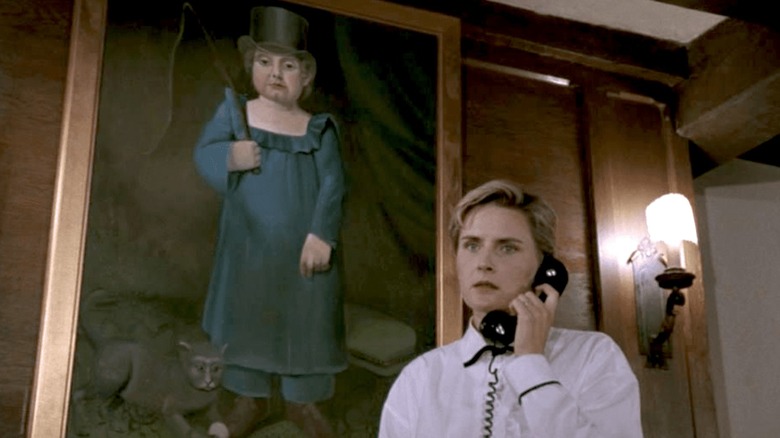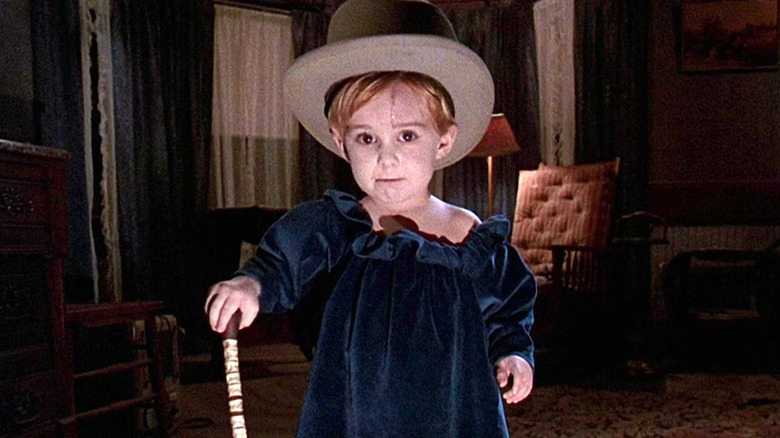The Creepy Painting In Pet Sematary Has A Morbid Hidden Meaning
Stephen King is at his best when he's writing about his fears as a father. With "The Shining," he took his alcoholism and made the lead Jack Torrance into a worst-case scenario, someone who destroys his family (and potential writing career) because he lets his addiction consume him. (If you ever wondered why King hates the Stanley Kubrick "Shining" film, the director's depiction of Jack is a big reason.)
Then there's "Pet Sematary," which is all about the primal fear any parent has of their child dying. The Creed family moves to rural Maine, in a house right next to a lethal road frequented by trailer trucks. After the family cat Church becomes roadkill, Dr. Louis Creed and neighbor Jud Crandall bury the cat in an ancient Mi'kmaq burial ground. Church returns, alive but worse for wear. When Louis' toddler son Gage is killed by another oncoming truck, he can't resist the temptation to bring his son back. If there's anything that could inspire a normal person to play Dr. Frankenstein, it'd be the chance to see their child again. Louis, though, pays the same price ol' Victor did.
"Pet Sematary" has spawned a handful of movies, the first (and best) being the 1989 adaptation of the novel, directed by Mary Lambert. Speaking to Entertainment Weekly about the movie 30 years later, Lambert revealed the creepy historical origins of the creepy painting above, and how it fits with the film's theme of parents grieving their dead children.
Don't leave your kids in the Pet Sematary
Creed family matriarch Rachel (played in the 1989 movie by Denise Crosby) has a terrifying backstory. As a child, she had to care for her disabled sister Zelda, who was afflicted with spinal meningitis. Zelda died while Rachel was watching her, and the latter confesses that she was relieved to be free of her sister, whose helplessness and pain had made her cruel and vindictive.
When Rachel goes back to her childhood home, where Zelda died, after Gage's death, there's a painting of a child in a gown and a top hat, with a cat by their feet. The painting symbolizes Gage and Church; when he returns from the grave Gage himself even wears the same outfit. Lambert explained that this piece of set dressing was modeled on real nineteenth-century American paintings of children who died in infancy, commissioned by their grieving parents.
"So many children died at an early age, and they wouldn't have any photographs of them, or pictures, so they would dress them. A lot of those pictures are of dead children that have been dressed so their parents can remember them. That's why they're so creepy, those portraits of 2, 3, [4], 5-year-old children dressed in weird little outfits and really stiff. That was my inspiration for how Gage comes back, because that's a form of bringing somebody back from the dead."
It's fitting that the painting hangs in the Goldman family home since they lost a child that they try not to remember. Lambert further confirmed the painting was crafted specifically for the film; certain costume designs (from the revenant Gage's top hat to Zelda's blue gown) are meant to reflect it. While the novel is still the best version of "Pet Sematary" (it's the kind of story where you need to live in the characters' heads for full impact), the painting and its associated motifs show how a visual medium like film can add new dimensions to a horror story.

